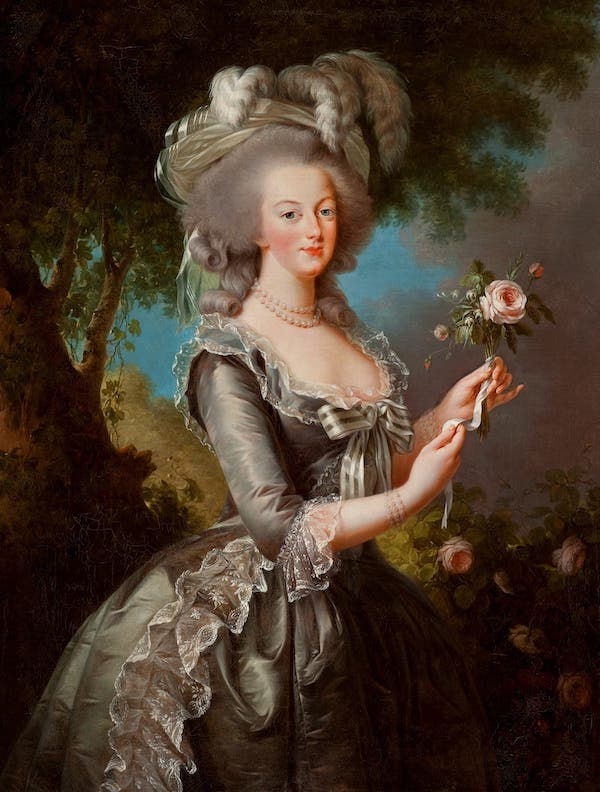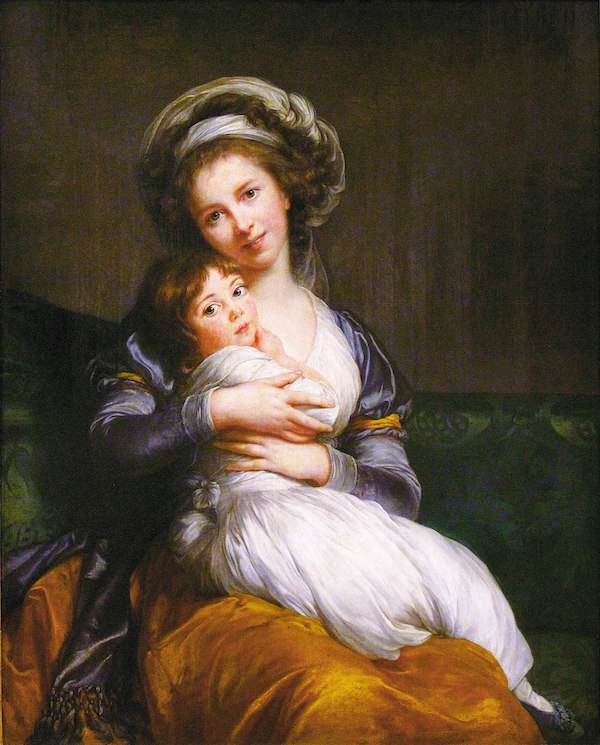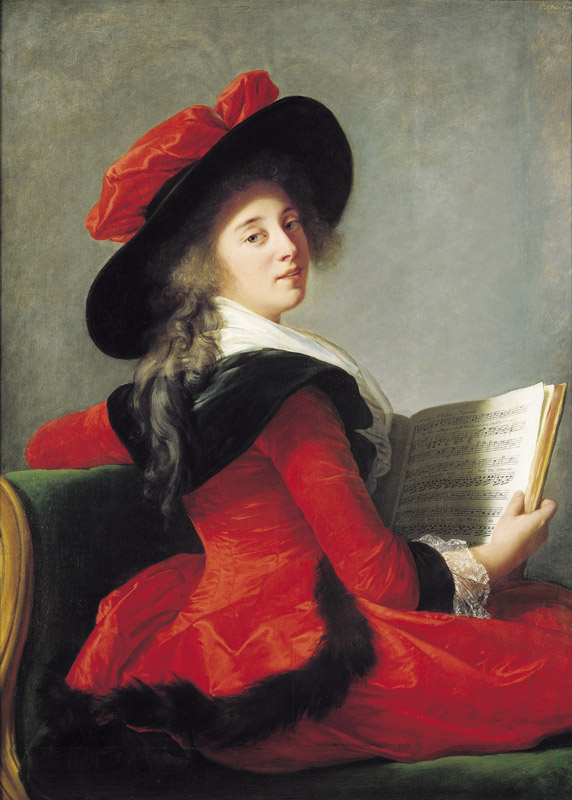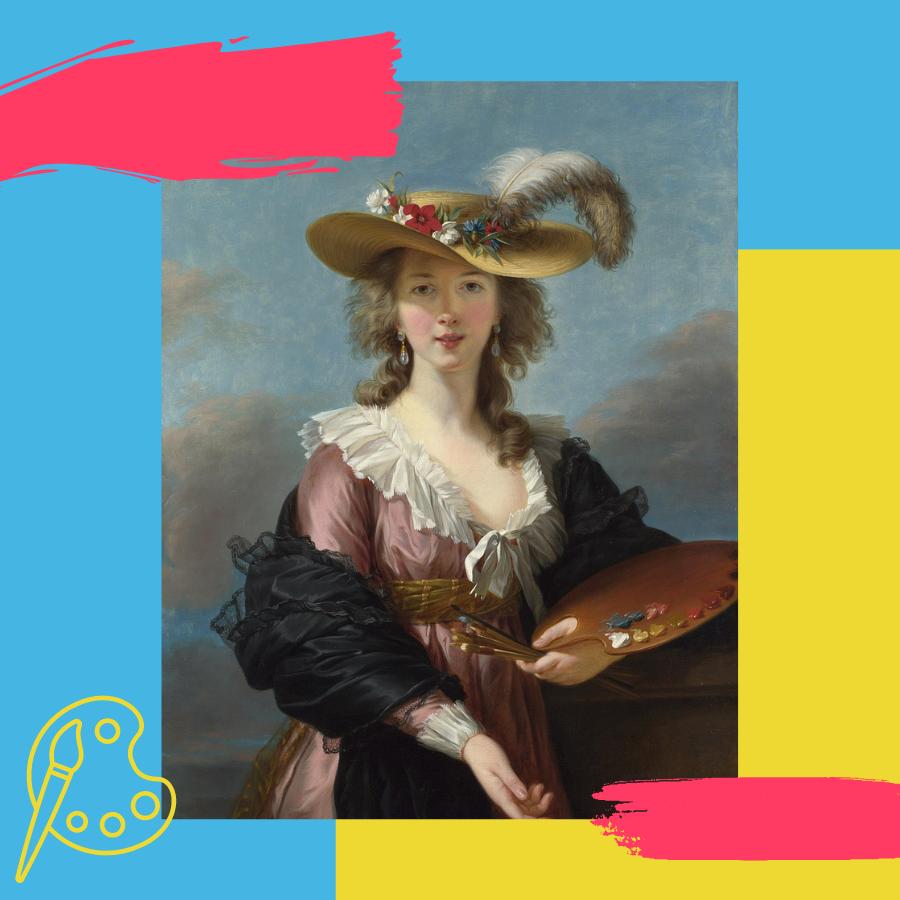Reclaiming the Canon is a series of posts that aims to bring attention to historical women who are often excluded from the narrative of their field — whether literature, music, science, or another area. Each post features a woman whose name we feel everybody should know. Readers are strongly encouraged to explore further resources, spend quality time with primary sources when possible, and self-educate — because re-claiming the canon starts with you!
Who Was Elisabeth Vigée Le Brun?
Elisabeth Vigée Le Brun was a French painter who lived from 1755-1842. Born in Paris, she was taught how to paint by her artist father and became a successful portraitist when she was only a teenager. She married at age 21 and continued her painting career, but the French Revolution drove her into exile. Alone with her daughter, Vigée Le Brun lived outside of France for 12 years. She painted portraits of European and Russian nobility. By the time she could finally return to Paris, she was a wealthy woman.
Vigée Le Brun’s 600+ portraits are an important record of 18th-century high society in Europe. She painted nearly 30 portraits of Marie Antoinette, in addition to portraits of other members of the royal family. Unapologetically interested in money and prestige, Vigée Le Brun continued to paint until her death at age 86.

Her Life
Young Elisabeth was a brilliant painter. Her father was a portraitist and pastellist who was her first art teacher. After he died when Elisabeth was only 12 years old, Elisabeth’s mother married a jeweler whom Elisabeth hated. Before she was 20 years old, Elisabeth had amassed a prestigious clientele and made more than enough money to support herself. She married art dealer Jean-Baptiste Le Brun when she was 21, likely as a way to leave the house of her stepfather.
Vigée Le Brun did not care for her husband, whom she accused in her memoirs of spending her money on “his overwhelming passion for extravagant women.” They had a child, Julie, together, but mother and daughter left the country at the outbreak of the French Revolution due to Vigée Le Brun’s strong ties to the French court. Her husband divorced her five years later, worried his property would be taken away because of his wife’s exile status.
When Vigée Le Brun returned to Paris, she enjoyed great fame and success. She excelled at self-promotion, which at this time meant the art of the self-portrait. Caroline Chapman writes in Eighteenth-Century Women Artists that Vigée Le Brun “was adept at promoting herself as a woman first, artist second.” This would have been crucial to her success in this time and place, as a woman acting like anything other than a woman was “supposed” to be was not only unacceptable but dangerous. In her self-portraits — and there are nearly 40 of them — Vigée Le Brun never shows herself in working clothes but instead paints herself in fashionable, feminine attire. She cultivates a perfect image of motherhood in her mother/daughter portraits, though in reality she was not a devoted parent and prided herself on never letting motherhood interfere with her work.
Despite her carefully constructed public image, Vigée Le Brun was not free from controversy. A mother/daughter self-portrait exhibited in 1787 caused a public scandal because she painted herself smiling open-mouthed, daring to show her teeth.

Even Simone de Beauvoir criticized Elisabeth Vigée Le Brun for her mother/daughter portraits, but for a different reason. In 1949, she wrote in The Second Sex: “Madame Vigée-Lebrun never wearied of putting her smiling maternity on her canvases.”
Her Contribution
Early in her impressive career, Elisabeth Vigée Le Brun was granted patronage by Marie Antoinette. In 1783, Vigée Le Brun became one of only 15 women to be granted membership in the Académie royale de peinture et de sculpture between 1648 and 1793. Throughout her life, she painted around 660 portraits and 200 landscape paintings. When she was in her 80s and still painting, she also published her memoirs in three volumes.
The first retrospective of Vigée Le Brun’s work in France (her native country) did not take place until 2015. Her paintings hang in museums like the Louvre, the Uffizi, the Metropolitan Museum of Art, and many more. And if her legacy of gorgeous eighteenth-century portraiture were not enough, Vigée Le Brun also believed that by encouraging her female models to dress more simply and comfortably for their portraits (and she urged them not to powder their hair), she changed the course of fashion.

In Her Words
In her memoirs, titled Souvenirs, Vigée Le Brun writes about her extensive travels, her illustrious painting career, and her day-to-day experience as a creative workaholic. Thankfully, she did learn the importance of a good after-dinner nap:
I continued to paint furiously, sometimes taking three sittings in the course of a single day. After-dinner sittings, which fatigued me extremely, brought about a disorder of my stomach, so that I could digest nothing and became wretchedly thin. My friends made me consult a doctor, who ordered me to sleep every day after dinner. At first it was some trouble to me to follow this habit, but by remaining in my room with the blinds down I gradually succeeded. I am persuaded that I owe my life to this rule.
– Elisabeth Vigée Le Brun, Souvenirs
Further Resources
- Caroline Chapman’s Eighteenth-Century Women Artists: Their Trials, Tribulations and Triumphs provides an excellent overview of women artists in the 1700s, including details on Vigée Le Brun and how she fit in (and didn’t fit in) with her fellow women artists.
- You can read Vigée Le Brun’s Souvenirs thanks to UPenn.
- Watch The Fabulous Life of Elisabeth Vigée Le Brun on Apple TV.
- Learn more about Elisabeth Vigée Le Brun over at The National Gallery website.
- Still deep diving? Check out Gita May’s biography Elisabeth Vigée Le Brun: The Odyssey of an Artist in the Age of Revolution.



I have a painting of her an her child. Message me an let me no more about it. Thanks